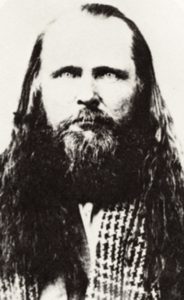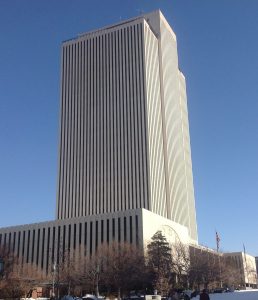Why are so many wonderful record-images beginning to appear on FamilySearch? The answer requires a long run-up …
Family history is an essential part of the practice of the Church of Jesus Christ of Latter-Day Saints, aimed at ensuring that everyone who has ever lived and who ever will live will ultimately be united in one great family tree. (Donald Akenson’s Some Family: The Mormons and How Humanity Keeps Track of Itself is a good, if slightly snide, account).

1813-1878. Not all Mormons were cuddly.
Because of this, the LDS have been collecting family history records since the 1890s and research in those records has been the main means of access to records for all family history researchers, Mormon and non-Mormon, for more than seventy years. Most Mormon temples have a Family History Centre that also opens to the public. Up to now, these Centres have depended on microfilm ordered via FamilySearch from the vast vaults of the Family History Library in Salt Lake City – their microfilms of the GRO registers are on open access in the Family History Centre in Dublin, for example.

Now that system is ending. From September 1st next, FamilySearch will discontinue its microfilm distribution services. The reason is simple: as microfilm declines in popularity the costs of storage and duplication have risen dramatically. In other words the internet killed it.
As a replacement FamilySearch promises that all its microfilm will be available as digital images. And that’s the reason for the tectonic shift we’ve been seeing recently in the availibility of Irish record images on the site: the Registry of Deeds, the GRO films, the Tithe survey, the National Archives testamentary collections and so much more. There is a simply a huge push on to get the films online before September.
Unfortunately, access permissions haven’t yet been sorted out for many of the records. Click on that tantalising little camera icon and more often than not you’ll be told: ” These images are viewable: 1. To signed-in members of supporting organizations. 2. When using the site at a family history center.”

I enquired if I could sign up to be a supporting organisation (“I’ll be ever so supporting, I promise”) only to be told that there is currently only one supporting organisation: the Church of Jesus Christ of Latter-Day Saints.
Personally, I’m delighted the microfilm is going. If they want someone to light the microfilm bonfire and dance around it, count me in. Thirty years spent squinting down microfilm readers has left me loathing the stuff.
Experience suggests that those viewing barriers will eventually melt. And in the meantime, I live quite close to the Dublin Family History Centre.
Many people do not live near a Family History Center. The loss of microfilm access to many records is a real disaster to us. Right now, I can order it and then read it at my local public library. I found, among other things, the 1863 NYC marriage of my great-great grandparents, both of Co Westmeath. The images were out of order and I had to slog thru most of the reel to find it. No city clerk would ever do that. And without the microfilm, I could not have either. With the film, I found the priest, then the church marriage record. A miracle. I think the LDS decision was hasty. Digitize first, then discontinue film.
I work at a Famiky History Library and the reason they are stopping film ordering is because the cost went up 10,000%! It now costs them $85 to copy one film in the vault. We are sorry this is such an inconvenience but it comes down to cost. Films will stay in libraries and genealogical societies until they are digitized and then Salt Lake FHC will recall them. They should all be online by 2020.
Sorry. Family History Center!
I hope they have better luck transitioning the microfilm records into the digital world. Three years ago, a new-found cousin (whose father was actually BORN in Ireland) and I went to a LDS site and searched for our Fordes from Fenagh, Co. Leitrim. We were giddy with excitement, but disappointed because either because the handwriting was impossible to read, or the microfilm was blurry, or the original records were in a sorry state. Or all of the above.
On the handwriting, I hate to admit to this, but we were both taught in the 1950s by the Sisters of (no) Mercy, and it’s possible that we have totally impossible standards. I know this much is true: my daughter has no chance of ever forging my signature. Her judgement, not mine.
I think the family history centers are at what they call a stake house. My FHC is at one where three wards(congregations/parishes) meet and worship, study and fellowship. There is an early hours one, a later morning/early afternoon and then a late afternoon/early evening. What an ingenious idea to maximize funds and space. Of course all cleaning and maintenance is done by the members. The temple is where LDS members have the ordinances including weddings are performed. We have a temple now here in town. I am not LDS so I may be wrong.
Some FH centers are adjacent to a temple, and some are in a chapel building or stake center. You are right that Sunday worship services are in the chapels, and the ordinances, including marriages, are performed in the temples.
You’re correct. FHCs are in ward buildings and stake centers, never at a temple. I’m LDS, so I know for sure! 🙂
Close enough. Details may vary a little according to local circumstances.
The LDS libraries have have many films on long term loan. I can only hope that those I’ve loaned aren’t returned for destruction believing that the digital form is adequate until proven. Looks like there are a few more films I need to order before September.
Responding to Jim Hollarn. Our local history library for viewing LDS film says long-term loans must be returned about Dec. 31, 2017.
I can promise you as a former staff member at FS that these decisions are not made hastily. As the FS article referenced below details, there are many reasons why some films will not be available digitally right away. Careful planning and many years of effort go into negotiating with repositories to allow records to be made available digitally and for free on FS and other partner sites. Read the article carefully and also follow the link at the end of the first paragraph that takes you to a page with Q&A regarding all the questions mentioned by others on this post.
http://media.familysearch.org/familysearch-digital-records-access-replacing-microfilm/
What hasn’t been answered is all of the effects on the affiliate libraries.
I have two FHC’s approximately equidistant from my home, both at about 45 minutes drive time. I have an affiliate library approximately 8 miles from home (10 minutes drive time). The FHC’s have hours of 2-3 hours, 2 days a week, evenings only. But not in bad weather. Or when someone’s sick. The library is open 9-5 Tuesday through Saturday, without fail.
It’s obvious where I choose to go, but will those films that are not allowed online (due to contractual problems), but viewable at a FHC, be viewable at an affiliate library? No one has answered that question. My library doesn’t know.
My library has said they have no idea if films will need to be returned (eventually), yet someone in this thread above posted all films must be back by December 31, 2017.
I have 6 long-term loans sitting at my library, for which I shelled out over $100, and may soon be faced with no access to the content of those films, since they most likely will have restrictions placed on online access. They certainly aren’t available online currently.
While I can do a hurry-up digging out what information I might know now from those films, this is a community, and everyone is related to everyone else (isn’t that always the case?). Where do I go when one set of clues leads me to someone else on that film? That I then can’t see.
It would be nice if they had provided a little more concrete/complete information.
The idea of “one great family tree” begs the question “why?” The next time you see Mormon missionaries walking along the road ask them this question. It may be worth your while.
I think this is great news.
Most of my ancestors were Catholic Irish who emigrated to Ontario, Canada. For several years now, I’ve been using FamilySearch’s online “Ontario, Roman Catholic Church Records, 1760-1923,” which is a collection of digitized images of the microfilms of the parish registers. This is so much easier than ordering microfilm and visiting a family history centre, and the records are available 24/7, and free of charge at that. By using FamilySearch’s digitized Ontario RC records in conjunction with the NLI’s digitized Irish RC records, I have been able to make some connections and to fill in some gaps — and without even leaving the comfort of my own home!
If FamilySearch makes good on its promise to eventually digitize all of its microfilm, I believe this will significantly increase access to the records, even though there will be some unfortunate lags in availability.
My local affiliate (public library) now has access to the digitized microfilms. Records formerly only available to view at an FHC or by borrowing microfilm can now be viewed on my laptop or a library computer.
It’s a wonderful thing!